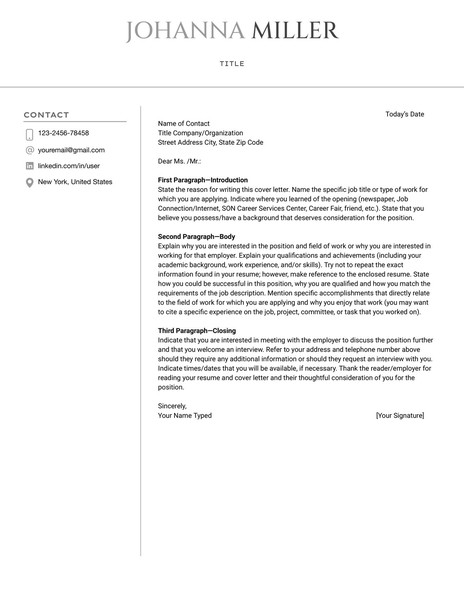A clean, structured Cover Letter template designed to meet the needs of job seekers across industries. Compatible with Google Docs, it supports fast customization while maintaining a polished, professional look suitable for any application.
Content & Design Features:
Clearly organized sections for contact details, greeting, body text, and sign-off.
Space to tailor the letter to specific job descriptions or employers.
Professional formatting that pairs seamlessly with matching resumes.
Editable in Google Docs — no software required.
Printable and shareable via link, PDF, or email attachment.
Designed to highlight skills and qualifications with clarity and confidence.
Ideal for professionals, recent graduates, and career changers aiming to make a strong impression in competitive job markets.
Format: Google Docs
How to Write a Cover Letter in Google Docs That Aligns Skills With Opportunity
A strong cover letter goes beyond formalities — it connects personal qualifications to a company’s needs. Whether applying for a creative, technical, or corporate role, a well-crafted letter demonstrates alignment, initiative, and clarity. Google Docs offers a flexible environment for planning, drafting, and formatting a compelling letter that can adapt across industries and experience levels.
This guide explains how to create an effective cover letter in Google Docs, covering structure, writing strategy, and formatting principles that support clarity and professionalism.
1. Define the Core Message Before Writing
Why it matters: A cover letter should not repeat the résumé — it should translate past experience into future potential. Start by identifying the role's key requirements and consider how your skills support them.
Preparation tips:
Review the job description and extract core themes (e.g., project ownership, client communication, strategic thinking).
Outline two to three points where your background directly responds to those themes.
Jot down specific contributions that illustrate those skills.
Use Google Docs' outline feature (View > Show Outline) to organize key ideas before drafting.
2. Follow a Clear, Proven Structure
Why it matters: Recruiters spend seconds scanning. A predictable, clean layout helps key information surface fast. A professional cover letter generally follows this format:
Header: Name, email, phone, LinkedIn, and optional city/state.
Date and Employer Info: Date, hiring manager name, title, company name, and address (if known).
Greeting: Formal but direct (“Dear [Hiring Manager’s Name]”).
Introduction: State the position and a quick snapshot of why you’re a match.
Body (1–2 paragraphs): Share relevant experience, achievements, and how they apply to this role.
Closing: Express enthusiasm and provide next steps (e.g., “looking forward to the opportunity to discuss further”).
Signature: Full name (typed; add handwritten version if submitting as PDF).
In Google Docs, use heading styles (Format > Paragraph styles) to ensure consistent spacing and visual alignment.
3. Focus on Contribution, Not Just Background
Why it matters: Hiring managers want to know what you’ll bring — not just where you’ve been.
Use sentence structures that reflect impact over activity:
Frame experience in terms of results, using quantifiable data where possible. Google Docs tables or two-column layouts can help organize achievements or contrast experience with job requirements.
4. Avoid Generic Language and Personalize the Value
Why it matters: A vague letter could apply to any role. A focused letter reflects research and intent.
Use job-specific language. If the role calls for “cross-functional collaboration,” reflect that directly in examples:
“Partnered with design and engineering to deliver product updates across three release cycles, improving feature delivery time by 20%.”
Use Google Docs' comment feature (Insert > Comment) to ask for peer review before finalizing.
5. Finalize Formatting for Professional Polish
Why it matters: Visual consistency reinforces credibility. Distractions like misaligned margins or uneven spacing can shift attention away from content.
Formatting checklist in Google Docs:
1" margins all around
Professional font (e.g., Georgia, Calibri, Arial) at 11–12 pt
Consistent line spacing (1.15–1.5 recommended)
Left-aligned text with no text justification
Export as PDF to preserve layout when submitting
Use File > Download > PDF Document (.pdf) for best cross-platform compatibility.
Why Google Docs Works Well for Cover Letters
Cross-device editing — Write from desktop, tablet, or phone
Version history — Track edits over time or revert to earlier drafts
Real-time collaboration — Share with mentors, peers, or editors for instant feedback
Template support — Start with structure, not from scratch
Final Thought: Translate Qualifications Into Future Impact
A great cover letter does more than describe — it persuades. It frames experience through the lens of the employer's needs, turning past roles into predictors of future success. Google Docs supports this clarity, letting job seekers focus on what matters: communicating readiness, relevance, and intent with precision.






